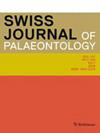埃及Kasimovian(宾夕法尼亚晚期)cornute rugose珊瑚:冈瓦纳北部冷水动物群的分类、相和古地理
IF 2.2
2区 地球科学
Q1 PALEONTOLOGY
引用次数: 0
摘要
本文从Aheimer组下部(埃及苏伊西湾西部)研究了一个强烈地方性的上宾夕法尼亚(Kasimovian) rugose珊瑚群,该珊瑚群由小型,大多数非分离,结构简单和多样性差的物种组成。该单元由灰色粉砂质泥岩与薄的铁质粉砂质白云岩-灰岩和钙质粉砂岩夹层组成。鉴定出4科10个分类群。新种有4种;鉴定出放线菌属(Actinophrentis crassithecata n. sp)、Lytvolasma aheimerensis n. sp、L. paraaucta n. sp、Monophyllum galalaensis n. sp.此外,还鉴定出Rotiphyllum exile de Groot, 1963和Bothrophyllum okense Kossovaya, 2001;目前仍有4个分类群(Lytvolasma cf. canada, Zaphrentites cf. parallela, Zaphrentites sp.和ufinia sp.)处于公开命名状态。再生、结壳和生物侵蚀现象罕见。成熟期的依恋结构不明显;根尖部的附着疤痕也很少见。珊瑚在泥质沉积物中的生长模式和嵌入情况表明,珊瑚以泥贴的形式生活在柔软的基质中。珊瑚内部孔洞的再结晶、白云化和铁成矿是最常见的成岩特征。来自下Aheimer组的珊瑚代表了典型的cyathaxonid动物群,它们适应了高碎屑输入和浑浊的水域,在古特提斯南部大陆架的一个有限的、隐蔽的、偶尔被风暴冲刷的内部斜坡环境中。时间平均斜坡模型显示,从莫斯科期的碳酸盐-硅-碎屑混合开放内斜坡环境到下Aheimer组(Kasimovian)的限制内斜坡环境,再到Gzhelian期的潮外环境到河流环境,这是一个倒退的发展过程。一般和局部的古气候因素表明变冷。除了与古特提斯西部的埃及与西班牙北部的关系外,通过顿涅茨盆地(和乌拉尔南部)与科迪勒拉-北极-乌拉尔地区存在联系,这是二叠纪中下时期的一个冷水省。埃及动物群似乎是后一个时间片的反热带cyathaxon类动物群的先驱,也是东西米利亚-冈瓦纳周围地体的下二叠世冷水动物群的先驱。本文章由计算机程序翻译,如有差异,请以英文原文为准。
Kasimovian (late Pennsylvanian) cornute rugose corals from Egypt: taxonomy, facies and palaeogeography of a cool-water fauna from northern Gondwana
A strongly endemic Upper Pennsylvanian (Kasimovian) rugose coral association consisting of small, mostly non-dissepimented, simple structured and poorly diversified species is studied from the lower member of the Aheimer Formation (Western side of the Gulf of Suez, Egypt). The unit is composed of grey, silty mudstone intercalated with thin, ferruginous, silty dolostone–limestone and calcareous siltstone beds. Ten taxa from four families were identified. Four species of the Antiphyllinae are new; Actinophrentis crassithecata n. sp., Lytvolasma aheimerensis n. sp., L. paraaucta n. sp. and Monophyllum galalaensis n. sp. Besides, Rotiphyllum exile de Groot, 1963 and Bothrophyllum okense Kossovaya, 2001 were identified; four taxa remain in open nomenclature (Lytvolasma cf. canadense, Zaphrentites cf. parallela, Zaphrentites sp. and Ufimia sp.). Rejuvenation, encrustation and bioerosion phenomena are rare. Attachment structures during mature stages are not evident; attachment scars in the apical parts are also rare. Growth patterns and embedding in the muddy deposits indicates that the corals lived as mudstickers in soft substrate. Recrystallization, dolomitization and ferrugination of open pore spaces inside the corals are the most common diagenetic features. The corals from the lower Aheimer Formation represent a typical cyathaxonid fauna that was adapted to high clastic input and turbid waters in a restricted, sheltered, episodically storm-swept inner ramp environment in an embayment of the southern shelf of the Palaeotethys. A time-averaged ramp model shows a regressive development from a mixed carbonate–siliciclastic open inner ramp setting during the Moscovian to the restricted inner ramp of the lower Aheimer Formation (Kasimovian) and following peritidal to fluvial environments of the Gzhelian. General and local palaeoclimatic considerations indicate cooling. Besides relations to northern Spain that root Egypt in the western Palaeotethys, connections existed via the Donets Basin (and the southern Urals) to the Cordilleran–Arctic–Uralian realm which is a cool water province during the Lower and Middle Permian. The Egyptian fauna appears to be a precursor of the anti-tropical cyathaxonid fauna of the latter time slice and also of the Lower Permian cool-water faunas of the east Cimmerian peri-Gondwana terranes.
求助全文
通过发布文献求助,成功后即可免费获取论文全文。
去求助
来源期刊

Swiss Journal of Palaeontology
Earth and Planetary Sciences-Paleontology
CiteScore
4.30
自引率
16.70%
发文量
17
审稿时长
4 weeks
期刊介绍:
The Swiss Journal of Palaeontology publishes original research and review articles of interest to the international community in the fields of palaeontology, taxonomy and systematics, while recognising at the same time the importance of documenting high-quality palaeontological data in a regional context. Palaeobiology in combination with alpha taxonomy is a core topic of the journal.
Submitted papers should have an appeal as wide as possible, directed towards an international readership. Contributions should not have been simultaneously submitted elsewhere, and the overlap of content between related articles should be minimal. Duplications of text and the use of previously published illustrations without adequate citation are unacceptable. If a manuscript has two or more authors, both or all have to sign to confirm they all were involved in the work and have agreed to its submission. The preferred manuscript language is UK English, but consistently used US English is also acceptable. We encourage the publication of proceedings of international meetings as well as special thematic issues. Short contributions and book reviews are also accepted.
An international editorial team as well as guest editors guarantee that the thematic issues as well as all articles in regular issues are peer-reviewed and meet the highest standards.
 求助内容:
求助内容: 应助结果提醒方式:
应助结果提醒方式:


